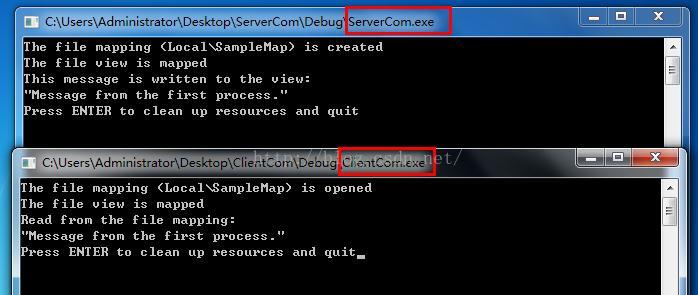C++进程间通信之共享内存
转载:http://blog.csdn.net/taily_duan/article/details/51692999
转载:http://blog.csdn.net/fengrx/article/details/4069088
转载:http://www.cnblogs.com/xuandi/p/5673917.html
// ServerCom.cpp : Defines the entry point for the console application.
// #include "stdafx.h" #include <stdio.h>
#include <windows.h>
#pragma endregion
#define MAP_PREFIX L"Local\\"
#define MAP_NAME L"SampleMap"
#define FULL_MAP_NAME MAP_PREFIX MAP_NAME // Max size of the file mapping object.
#define MAP_SIZE 65536 // File offset where the view is to begin.
#define VIEW_OFFSET 0 // The number of bytes of a file mapping to map to the view. All bytes of the
// view must be within the maximum size of the file mapping object (MAP_SIZE).
// If VIEW_SIZE is 0, the mapping extends from the offset (VIEW_OFFSET) to
// the end of the file mapping.
#define VIEW_SIZE 1024 // Unicode string message to be written to the mapped view. Its size in byte
// must be less than the view size (VIEW_SIZE).
#define MESSAGE L"Message from the first process." int _tmain(int argc, _TCHAR* argv[])
{
HANDLE hMapFile = NULL;
PVOID pView = NULL; // Create the file mapping object.
hMapFile = CreateFileMapping(
INVALID_HANDLE_VALUE, // Use paging file - shared memory
NULL, // Default security attributes
PAGE_READWRITE, // Allow read and write access
, // High-order DWORD of file mapping max size
MAP_SIZE, // Low-order DWORD of file mapping max size
FULL_MAP_NAME // Name of the file mapping object
);
if (hMapFile == NULL)
{
wprintf(L"CreateFileMapping failed w/err 0x%08lx\n", GetLastError());
goto Cleanup;
}
wprintf(L"The file mapping (%s) is created\n", FULL_MAP_NAME); // Map a view of the file mapping into the address space of the current
// process.
pView = MapViewOfFile(
hMapFile, // Handle of the map object
FILE_MAP_ALL_ACCESS, // Read and write access
, // High-order DWORD of the file offset
VIEW_OFFSET, // Low-order DWORD of the file offset
VIEW_SIZE // The number of bytes to map to view
);
if (pView == NULL)
{
wprintf(L"MapViewOfFile failed w/err 0x%08lx\n", GetLastError());
goto Cleanup;
}
wprintf(L"The file view is mapped\n"); // Prepare a message to be written to the view.
PWSTR pszMessage = MESSAGE;
DWORD cbMessage = (wcslen(pszMessage) + ) * sizeof(*pszMessage); // Write the message to the view.
memcpy_s(pView, VIEW_SIZE, pszMessage, cbMessage); wprintf(L"This message is written to the view:\n\"%s\"\n",
pszMessage); // Wait to clean up resources and stop the process.
wprintf(L"Press ENTER to clean up resources and quit");
getchar(); Cleanup: if (hMapFile)
{
if (pView)
{
// Unmap the file view.
UnmapViewOfFile(pView);
pView = NULL;
}
// Close the file mapping object.
CloseHandle(hMapFile);
hMapFile = NULL;
} return ;
}
// ClientCom.cpp : Defines the entry point for the console application.
// #include "stdafx.h"
#include <stdio.h>
#include <windows.h>
#pragma endregion
#define MAP_PREFIX L"Local\\"
#define MAP_NAME L"SampleMap"
#define FULL_MAP_NAME MAP_PREFIX MAP_NAME // File offset where the view is to begin.
#define VIEW_OFFSET 0 // The number of bytes of a file mapping to map to the view. All bytes of the
// view must be within the maximum size of the file mapping object. If
// VIEW_SIZE is 0, the mapping extends from the offset (VIEW_OFFSET) to the
// end of the file mapping.
#define VIEW_SIZE 1024 int _tmain(int argc, _TCHAR* argv[])
{
HANDLE hMapFile = NULL;
PVOID pView = NULL; // Try to open the named file mapping identified by the map name.
hMapFile = OpenFileMapping(
FILE_MAP_READ, // Read access
FALSE, // Do not inherit the name
FULL_MAP_NAME // File mapping name
);
if (hMapFile == NULL)
{
wprintf(L"OpenFileMapping failed w/err 0x%08lx\n", GetLastError());
goto Cleanup;
}
wprintf(L"The file mapping (%s) is opened\n", FULL_MAP_NAME); // Map a view of the file mapping into the address space of the current
// process.
pView = MapViewOfFile(
hMapFile, // Handle of the map object
FILE_MAP_READ, // Read access
, // High-order DWORD of the file offset
VIEW_OFFSET, // Low-order DWORD of the file offset
VIEW_SIZE // The number of bytes to map to view
);
if (pView == NULL)
{
wprintf(L"MapViewOfFile failed w/err 0x%08lx\n", GetLastError());
goto Cleanup;
}
wprintf(L"The file view is mapped\n"); // Read and display the content in view.
wprintf(L"Read from the file mapping:\n\"%s\"\n", (PWSTR)pView); // Wait to clean up resources and stop the process.
wprintf(L"Press ENTER to clean up resources and quit");
getchar(); Cleanup: if (hMapFile)
{
if (pView)
{
// Unmap the file view.
UnmapViewOfFile(pView);
pView = NULL;
}
// Close the file mapping object.
CloseHandle(hMapFile);
hMapFile = NULL;
} return ;
}
注:运行的时候先运行写入的进程,再运行读出的进程

C++进程间通信之共享内存的更多相关文章
- 浅析Linux下进程间通信:共享内存
浅析Linux下进程间通信:共享内存 共享内存允许两个或多个进程共享一给定的存储区.因为数据不需要在客户进程和服务器进程之间复制,所以它是最快的一种IPC.使用共享内存要注意的是,多个进程之间对一给定 ...
- Linux环境进程间通信(五): 共享内存(下)
linux下进程间通信的几种主要手段: 管道(Pipe)及有名管道(named pipe):管道可用于具有亲缘关系进程间的通信,有名管道克服了管道没有名字的限制,因此,除具有管道所具有的功能外,它还允 ...
- Linux环境进程间通信(五): 共享内存(上)
linux下进程间通信的几种主要手段: 管道(Pipe)及有名管道(named pipe):管道可用于具有亲缘关系进程间的通信,有名管道克服了管道没有名字的限制,因此,除具有管道所具有的功能外,它还允 ...
- Linux进程IPC浅析[进程间通信SystemV共享内存]
Linux进程IPC浅析[进程间通信SystemV共享内存] 共享内存概念,概述 共享内存的相关函数 共享内存概念,概述: 共享内存区域是被多个进程共享的一部分物理内存 多个进程都可把该共享内存映射到 ...
- Linux进程间通信—使用共享内存
Linux进程间通信-使用共享内存 转自: https://blog.csdn.net/ljianhui/article/details/10253345 下面将讲解进程间通信的另一种方式,使用共享内 ...
- Linux进程间通信——使用共享内存
一.什么是共享内存 顾名思义,共享内存就是允许两个不相关的进程访问同一个逻辑内存.共享内存是在两个正在运行的进程之间共享和传递数据的一种非常有效的方式.不同进程之间共享的内存通常安排为同一段物理内存. ...
- linux进程间通信之共享内存篇
本文是对http://www.cnblogs.com/andtt/articles/2136279.html中共享内存(上)的进一步阐释说说明 1 共享内存的实现原理 共享内存是linux进程间通讯的 ...
- linux内核剖析(十一)进程间通信之-共享内存Shared Memory
共享内存 共享内存是进程间通信中最简单的方式之一. 共享内存是系统出于多个进程之间通讯的考虑,而预留的的一块内存区. 共享内存允许两个或更多进程访问同一块内存,就如同 malloc() 函数向不同进程 ...
- Linux进程间通信——使用共享内存(转)
一.什么是共享内存 顾名思义,共享内存就是允许两个不相关的进程访问同一个逻辑内存.共享内存是在两个正在运行的进程之间共享和传递数据的一种非常有效的方式.不同进程之间共享的内存通常安排为同一段物理内存. ...
- Python进程间通信之共享内存
前一篇博客说了怎样通过命名管道实现进程间通信,但是要在windows是使用命名管道,需要使用python调研windows api,太麻烦,于是想到是不是可以通过共享内存的方式来实现.查了一下,Pyt ...
随机推荐
- 计数器控件实例 NumericStepper
计数器控件实例 书:158 <?xml version="1.0" encoding="utf-8"?> <s:Application xml ...
- sqli-labs(十三)(hpp)
第二十九关 这关说的是有waf,其实只是模拟waf的场景,就是说waf处理的变量和后台程序接受的变量不一致. 考验的参数污染,具体可以参考其他文章关于HPP的解释. 先看源码吧: 输入?id=1&am ...
- UVA 10256 The Great Divide(点在多边形内)
The Great Divid [题目链接]The Great Divid [题目类型]点在多边形内 &题解: 蓝书274, 感觉我的代码和刘汝佳的没啥区别,可是我的就是wa,所以贴一发刘汝佳 ...
- 纯HTML和CSS实现点击切换
<!DOCTYPE html> <html lang="en"> <head> <meta charset="UTF-8&quo ...
- struts2.0自定义类型转换
在Struts2.0框架中内置了类型转换器,可以很方便的实现在八大数据类型.Date类型之间的自动转换:此外也可以根据自己的需求自定义数据转换类.如下: 首先看一下项目工程中的目录 1.在新建的web ...
- Java集合-----Map详解
Map与Collection并列存在.用于保存具有映射关系的数据:Key-Value Map 中的 key 和 value 都可以是任何引用类型的数据 Map 中的 ...
- 从windows本地IDE启动远程Linux文件进行调试
1) 因为WingIDE调用putty和plink进行ssh连接,需要先设置putty. 点击下载putty,并解压,把解压路径附到操作系统PATH环境变量中,之后重新启动WingIDE,让它重新读 ...
- python实现堆栈和队列
利用python列表实现堆栈和队列 堆栈: 堆栈是一个后进先出的数据结构,其工作方式就像生活中常见到的直梯,先进去的人肯定是最后出. 我们可以设置一个类,用列表来存放栈中的元素的信息,利用列表的app ...
- JAVA 中的 Collection 和 Map 以及相关派生类的概念
JAVA中Collection接口和Map接口的主要实现类 Collection接口 Collection是最基本的集合接口,一个Collection代表一组Object,即Collection的 ...
- Map集合——双列集合
双列集合<k, v> Map: Map 和 HashMap是无序的: LinkedHashMap是有序的: HashMap & LinkedHashMap: put方法: 其中,可 ...
